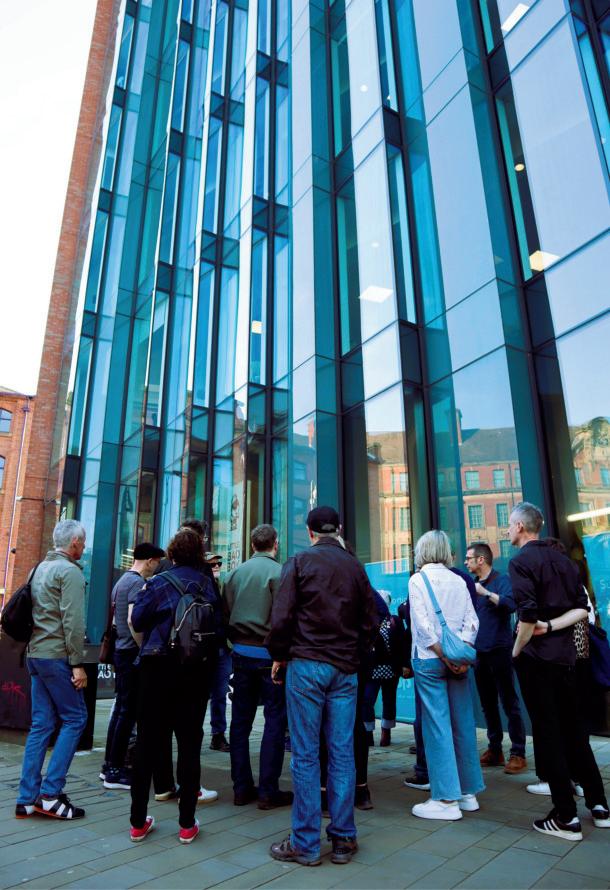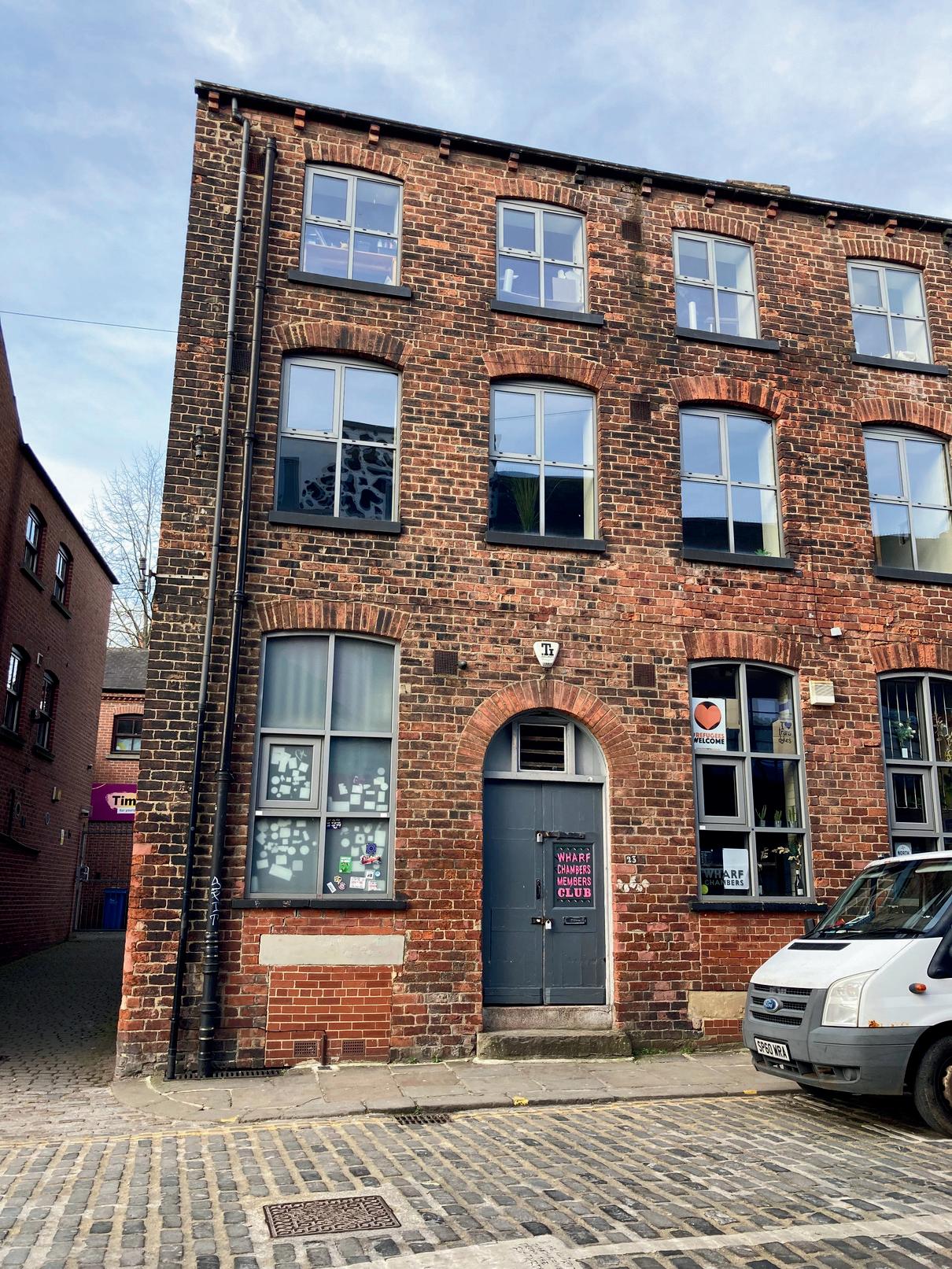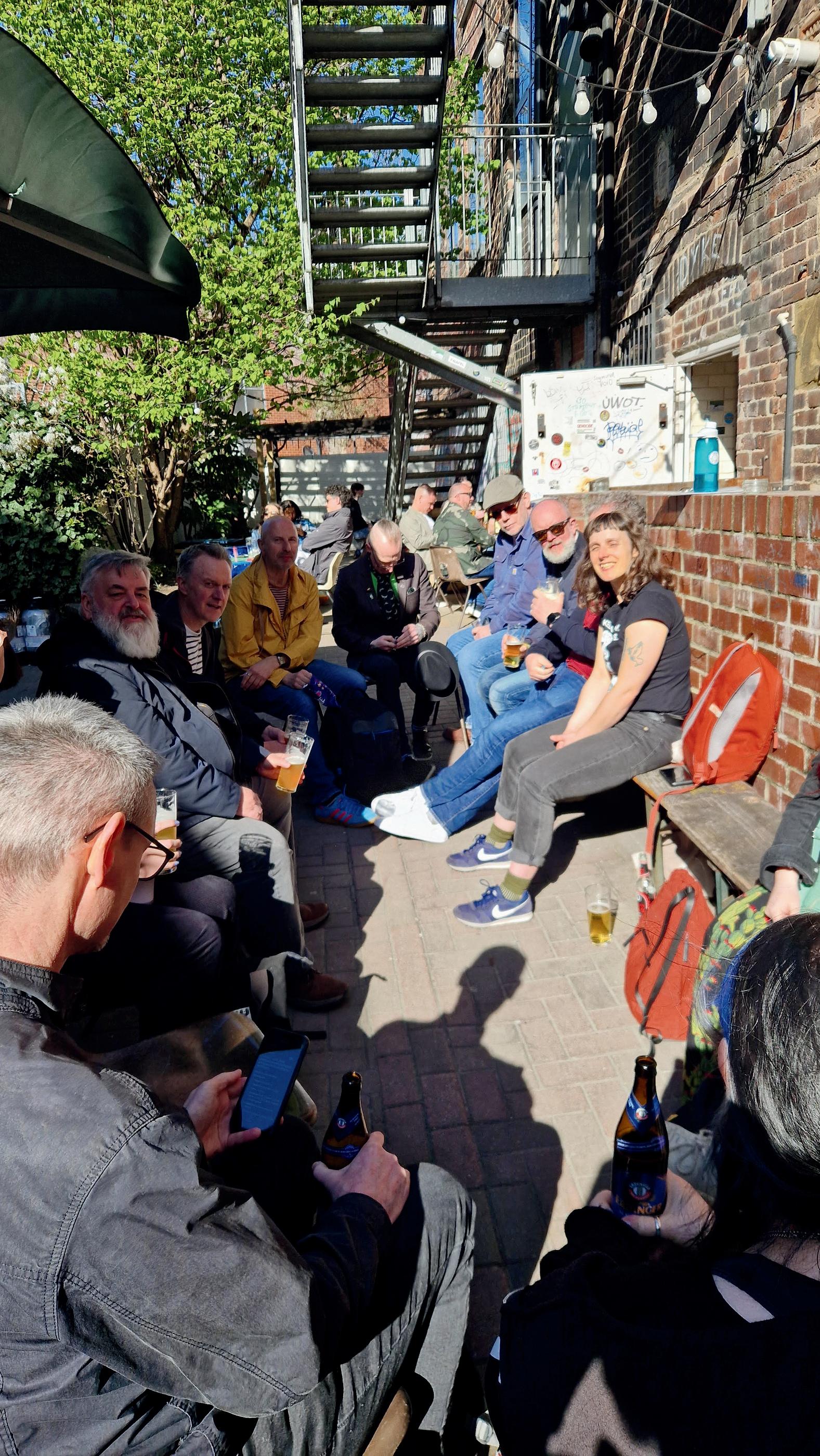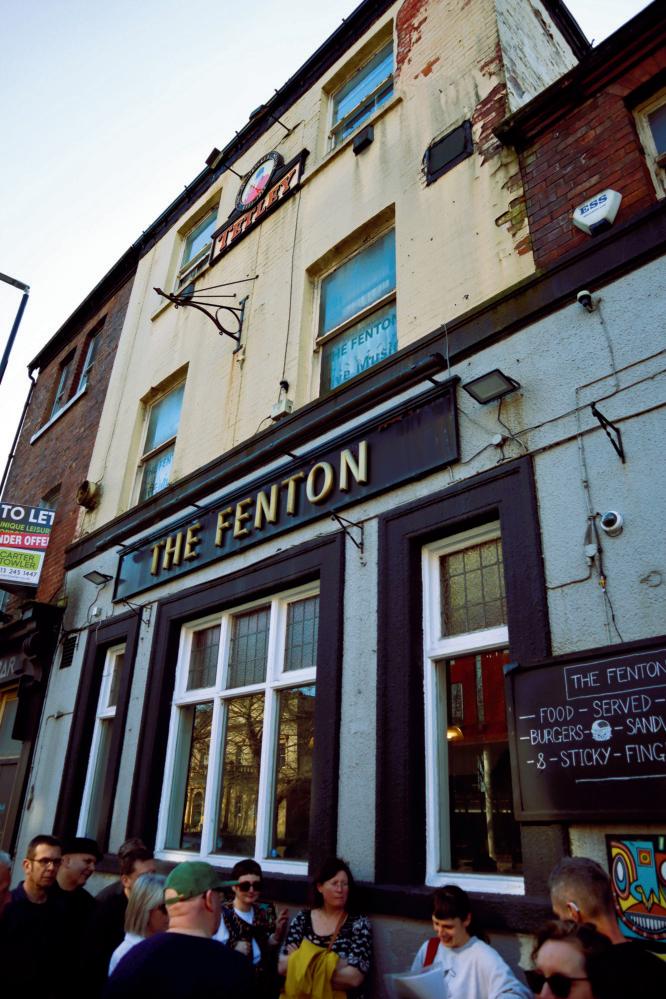INTRODUCTION
In the late 1970s Leeds was experiencing a recession, the National Front were spreading racism on the streets, Peter Sutcliffe, the so-called Yorkshire Ripper, was murdering women, and football hooliganism was rife. Against this backdrop, a particular form of punk and post-punk emerged and challenged the pervasive violence with positive anti-racist and anti-sexist messages. The Punk and Post-Punk walk visits key sites from the University down to the legendary F Club, and discusses the roles of important players in the scene. The walk brings to life the socio-political context of Leeds at the time – the shadow of the Ripper, the poverty and violence, the arts courses at the city’s universities – that contributed to the sound and politics of Leeds’ own interpretation of punk and post-punk, and explores the music’s ongoing legacy in the city. The walk was devised by local musician Sarah Statham and Leeds music researcher, Dr Rosemary Lucy Hill.
Sarah Statham moved to Leeds in 2007 and her first encounter with the music scene immediately inspired her to relocate and champion Leeds for its encouragement of collaboration and community. Since then she has been involved with over 20 musical projects, including her solo project Fig By Four, founded label/events group Bomb the Twist, and helped run DIY music space CHUNK. Her latest album, Capture Reveal, is out now.
THE ROUTE
Start: Parkinson Building, University of Leeds, Woodhouse, Leeds LS2 9JT
End: Wharf Chambers, 23-25 Wharf Street, Leeds LS2 7EQ
Length: approx. 2.3 miles







Sarah Statham. Credit David Gleave

University of Leeds, Woodhouse, Leeds LS2 9JT
The University of Leeds holds significant importance in the history of punk and post-punk in Leeds. In 1976, members of Leeds bands like Gang of Four, The Mekons, and Delta 5 studied art at the university.
They were taught by radical left wing and feminist lecturers such as Griselda Pollock and TJ Clark. Pollock argued that understandings of art should shift away from theories of ‘Great Men’ – the idea of the isolated artist – and should focus on artistic communities, how artists collaborated and influenced one another. TJ Clark had been a member of Situationist International. The SI movement theorised that capitalism worked through images and spectacle, and that it could be challenged through the construction of moments of everyday spectacle to reignite authentic desires. Art was seen as a way to change society; art was seen as a communal activity. You can see how the seeds of a specific kind of punk movement were sown.
The Faversham pub behind Leeds University (Springfield Mount), was an important meeting place for students, for plotting and for forming bands. Jon Langford of The Mekons remembers people would all be sitting in different corners depending on which band they were in. Later the Faversham become known for its association with goth, then dance, and in the late 1990s, hip hop.
Also here at the University in 1980, 300 feminists protested against heavy metal misogyny outside an Iron Maiden gig at the Refectory (Lupton Place). When the police tried to arrest them, the protestors blockaded the police van.
The Fenton, 161-165 Woodhouse Lane, Woodhouse, Leeds LS2 3ED
Head down Woodhouse Lane in the direction of the city centre.
Like The Faversham, the Fenton pub was an important meeting point for punks, a home for DIY planning, and a left activism hub. Gang of Four rehearsed next door at the University film society.
According to Dave Simpson, “When they nipped to the pub, their friends picked up their instruments and called themselves Mekons”.
In the late 1970s, there was a huge amount of tension between left punks and the National Front (NF) in Leeds. The NF were a presence in the city and images from the time show swastikas and NF graffiti on walls in Little London. Some city centre pubs had become the domain of one or the other: the Scarborough Taps (Bishopgate Street) and the Adelphi (Hunslet Road) were NF strongholds, whilst the Fenton was anti-fascist territory.


In 1978, a group of NF members who had earlier gatecrashed a Sham 69 gig at the F Club in Chapeltown, turned up at The Fenton and, according to The Mekons’ Kevin Lycett, ‘I think they thought: “There’s a load of weirdos and anarchists there and we’re going to hurt them” […] “Somebody picked up a beer glass and threw it across the room and it hit Dick, a political activist. Everyone got up and we chased them down the street. After a short running battle, it was over, but it was shocking, because this was the only place we had”’.
This ‘attack’ has become a legendary moment in the mythology of Leeds’ punk and post-punk. It’s part of the story of the importance of anti-fascist politics for punk, and part of Leeds’ long-running anti-racist history (see also, the Battle of Holbeck Moor, 1936).

Leeds Beckett Students’ Union, Portland Building, Portland Way, Leeds LS1 3HE
Continue down Woodhouse Lane and turn right into Portland Way.
Leeds Beckett SU is on your right. Leeds Beckett was formerly Leeds Polytechnic, and it has its own special place in Leeds music history. In punk history, there are two especially important moments: the first is the Sex Pistols gig in 1975; and the second is the UK’s second Rock Against Racism gig in 1977. The Sex Pistols played here on 6th December 1976, the first date to actually happen on their Anarchy tour, most of which got cancelled due to public safety concerns. The other bands on the bill were The Clash, The Damned and The Heartbreakers. The Pistols had previously played the Fforde Grene in Harehills in September 1975 (the pub that inspired Chumbawumba’s ‘Tubthumping’), so coming to the much bigger student union venue was an indication of their success.
The gig was very influential for Leeds’ fledgling punk scene. David Whittaker was a young printer at the time. He told the BBC, “I remember the noise, every band counted each song in and out. This was my first taste of punk. I, like most other people there, just stood and gazed in total confusion, at what was happening on the stage. I remember Captain Sensible of the Damned signing an autograph for a girl, when he had done it and left, I asked the girl if I could see it, she obliged. It read, ‘I’m not signing my f******* name on this’.”
The future members of The Mekons were there and Kevin Lycett later recalled to Leeds music journalist Dave Simpson that the Sex Pistols “were fucking awful, but they had an amazing attitude. I came away thinking: ‘We can do this.’ I’d never felt that way about anything before.” And he was not the only one: Green Gartside, who was studying fine art at Leeds Polytechnic, was at the gig and it inspired him to form Scritti Politti.
John Keenan was putting on gigs (Buzzcocks, Wayne County, Police), and Claire Shearsby was the DJ. Claire was the ‘person that that whole scene rotated around’, according to Choque Hosein of Salvation and Black Star Liner. More about John and Claire later.
The first Rock Against Racism concert was held in London, but the second was held in a portacabin behind the Leeds Polytechnic Student Union building in 1977. Whilst nationally RAR was a direct response to Eric Clapton’s racist tirade at Birmingham Uni, in Leeds the National Front were an ever-present evil in the 1970s. Swastikas and NF slogans were graffitied round the city. Leeds had been a thriving industrial city (textiles mostly), but the 1970s and 1980s saw the decline of those industries in the recession
Paul Furness, co-organiser of the RAR gigs, told author Daniel Rachel that, “Leeds was a very big industrial city then. It was very monochrome, and the buildings were really black with over 100 years of pollution and lots of the streets were derelict. The whole place looked like a building site. There was this real sense of fear. The National Front were vicious and running riot…[T]here was ‘NF’ graffiti all over… [T]hey were absolutely brutal…[W]e’d be selling Socialist Worker on a Saturday and they would come down…[I]t ended up in fights all the time.” Paul and others began the RAR gigs to reclaim the city from the fascists. Punk wasn’t only anti-fascist though, and there were NF affiliated punk bands in the city; RAR was making a statement against that relationship too.
After the first gig, a RAR club started in 1978 and put on gigs at the Roots club in Chapeltown (Francis Street, also known as the Cosmo). Bands were Black, white, punk, reggae. Andy Gill of Gang of Four says, “RAR was enormously important in Leeds both as a platform for bands and a banner people could rally round.” Roots was also where John Keenan moved to after leaving the Poly. He started the F Club, which stood for ‘f*** the Poly’ (more on the F Club below).
At the start of July 1981, there was a Northern Carnival Against Racism in Potternewton Park which featured Aswad, Specials (debuting ‘Ghost Town’), Misty In Roots, Rhoda Dakar, Selecter, Au Pairs and others, alongside talks. Leeds artist and musician Marcia Brown says, ‘The Rock Against Racism concert was one of the biggest things in my life; in fact it was the first concert that I went to. The whole vibe of why I think Rock Against Racism was so powerful was, for me, the unity of the musicians together to fight racism’. Homer Harriott of Leeds reggae band Bodicean said it opened his eyes politically to understand what was happening to the Black community as a racist issue.

Merrion Centre, LS2 8NG
Continue down Woodhouse Lane and enter the Merrion Centre via the entrance after Morrisons.
Take the right hand arm through the shopping centre to where it splits at The Works and the pop-up shop (this hosts artwork by the Burley Banksy the Rowland Emmet flying machine, which used to sit outside Morrisons). There used to be a staircase here, underneath which was a newsagents and a door down to Le Phonographique club, or Le Phono, below.
Le Phono is best remembered as, according to Spooky Isles magazine, ‘the de facto headquarters’ of the Leeds goth scene’. Goth famously started in Leeds as an offshoot of the post-punk scene (see Leeds Goth Walking Tour), and Le Phono ran regular goth nights here up until the club closed in 2005.
Spooky Isles writer recalls that it was ‘A basement nightclub with a small dancefloor that had a central, mirrored pillar, the Phono’s eccentric lay-out was the reason why the famous and celebrated gothic ‘twostep’ back-and-forth dance was invented. Once home to numerous regular nights as well as the ‘Sunday club’ goth night, the long-lamented Phono is now a retail storage unit.’
The F Club also held some gigs at Tiffany’s nightclub upstairs in the Merrion Centre (tickets could be bought at Jumbo).


23 Eastgate, Leeds LS2 7LY

Exit the Merrion Centre past Jumbo Records onto Wade Lane and turn right and then left to go down Merrion Street. Continue down Lower Merrion Street (the Roxy Ballroom was once the site of the Gallery club and home of Back to Basics). Turn right down Vicar Lane, past the Old Red Bus Station (now an electronic music venue) then left into Eastgate.
Punk wasn’t all politics, of course. No. 23 Eastgate (empty unit, opposite White Company) was where Ros Allen from Delta 5 remembers, “drinking ourselves silly at the Heaven and Hell nightclub, where Sylvester’s Mighty Real was a favourite floor-filler”. The Heaven and Hell nightclub (not to confused with the later club in the Grand Arcade) had two floors and billed itself as a ‘double decker disco’. It was a noted punk and alternative venue.
Marc Almond was a promoter at the Heaven and Hell club. He grew up in Horsforth, and then studied fine art at Leeds Polytechnic, where he met David Ball. Together they formed Soft Cell in 1977 and did their first gig at the Poly in 1979. They went on to have a number one hit with their cover of Gloria Jones’ ‘Tainted Love’.
BOSS Store, 71-75 Vicar Lane, Leeds LS1 6QA 7LY
Head back up hill and turn left into Vicar Lane. Note the blue plaque on the Hugo Boss shop on your right. The plaque celebrates the shop’s former life as the Duchess of York pub and music venue. The Duchess was a legendary live music venue operating from 1988-2000, and an important legacy of Leeds’ punk and post-punk scene.


In 1988, John Keenan, the promoter of the F Club, took on the role of promoter at The Duchess, and working with venue manager Miranda McMullen, they put on live bands every night of the week. Miranda McMullen describes the venue as “hot and sweaty, but with great energy”. Her vision transformed a dirty, leaky pub into a venue that touring bands wanted to come to: she cleaned it up, created welcoming backstage areas and provided hot food for bands. Kennan booked national and international bands and The Duchess became a key part of bands’ touring schedule, a destination venue in the North. Its reputation was such beyond Leeds, that, as Danny McNamara from Embrace remembers, “We actually got signed by playing at the Duchess because it was one of the few venues where record companies would be prepared to come and see you.”
The venue closed in 2000 when the lease was sold to Hugo Boss. The final gig was Chumbawumba. The closure of The Duchess was very sad for many in the Leeds music scene and the venue is much missed. And yet we get knocked down, but we get up again – Josephs Well (Hanover Square) and the Brudenell Social Club (Queen’s Road, Hyde Park) became go to venues for local and bigger bands, and John Keenan is still promoting gigs at the latter.
City Square, Leeds LS1 2HA
Continue down Vicar Lane, turn right into King Edward Street, follow across Briggate into Albion Place. Then turn left into Albion Street (Leeds’ first music hall was opened here in 1794), right at Boots into Bond Street, left into Park Row, and follow downhill into City Square.
Between 1975 and 1980 Peter Sutcliffe, the so-called Yorkshire Ripper, raped and murdered at least 13 women and attempted to murder at least seven more in Leeds and across West Yorkshire. Women were living in fear: Claire Shearsby remembers that women “wore their flat boots” so they could run if needed, and banded together in groups so they didn’t have to walk home alone.
The police failed to catch Sutcliffe for five years, despite interviewing him nine times. They relied on misogynistic ideas about the victims and put in place a de facto curfew on women. Leeds women were enraged at police incompetence and limits on their own behaviour when it was known to be a man who was doing the killings. Leeds Revolutionary Feminists organised the first Reclaim The Night march on 12 November 1977. There were two marches: one from Chapeltown and one from Woodhouse. They converged here in City Square. th


One of the important things about Leeds’ triumvirate of (post)punk bands at the time (Delta Five, Gang of Four, The Mekons) was that not only were they anti-racist, but anti-sexist too. Lucy O’Brien, of punk band The Catholic Girls, described Leeds at the time as a ‘paranoid atmosphere of gender warfare’ and the music coming out of the punk scene as ‘the sound of collective trauma’. Women were subject to misogyny and harassment generally in Leeds, and even whilst on stage, female musicians faced sexual harassment, including from Leeds United Fans.
When O’Brien moved to London, she realised that living in Leeds had been like living in a ‘a war zone’ on the frontline of the battle for women’s rights: “Leeds, Manchester, Bradford - these were all Northern cities that had been deeply affected by Peter Sutcliffe and the brutal macho values he acted out.”
North Taproom, Swinegate, Leeds LS1 4AG
Exit City Square to the east via Bishopsgate Street and keep left to pass the Scarbrough Hotel and the Moot Hall Inn. Follow Swinegate under the railway arches. As you come out the other side, note on the left the old door of the Cockpit, once a thriving music venue famous for its rock and metal nights.
On your right, where North Taproom is now, was once another music venue, Queens Hall. Queens Hall was a 5000 capacity music venue in an old tram shed (Swinegate Tram Depot). It opened in 1961 and closed in 1989, leaving a gap for large venues in the city. Many big names in 1970s and 1980s rock played here: The Police, Kiss, Bon Jovi, AC/DC. Motorhead recorded parts of their No Sleep ‘til Hammersmith live album here (and at City Hall Newcastle). Lemmy – and many who remember going to gigs there – remembered that it was freezing cold with poor acoustics.


In September 1979, John Keenan booked Queens Hall for the Futurama festival, billed as ‘the world’s first science fiction music festival’. Some of the bands on bill were Echo and the Bunnymen, the Fall, Hawkwind, OMD and Joy Division. It was a celebration of music in the north, with over half the bands coming from Leeds, Liverpool, Manchester and Sheffield. The festival ran again the following year when some of the bands were Siouxsie and the Banshees, Hazel O'Connor, Psychedelic Furs and Soft Cell.
Peter, of vintagerock.com blog, remembers travelling down from Middlesborough: “When we arrived it looked like a war zone. Punk fans from all over the north, and further afield, had decamped there for the weekend, and had been in the venue all night, sleeping on the floors; there was trash everywhere. We saw faces that we recognised from Middlesbrough Rock Garden, which had closed for the weekend as everyone was going to the festival.
We chatted to a few people; everyone was talking about how great Siouxsie (who had headlined the Saturday night) had been. … But the highlight was an incredible performance by Notsensibles, a punk band from Burnley who had some success with their single “I’m in Love with Margaret Thatcher”. Their set included a lot of tongue-in-cheek songs, all performed in their strong Northern accent. They’d brought a large contingent of fans, who all sang along with every daft song. Notsensibles motto was “all we want to do is make silly records and play silly gigs”.”

Revolución de Cuba, 64-68 Call Lane, Leeds, LS1 6DT
Keep left to follow Swinegate round until it meets Call Lane and Lower Briggate. In the 1970s and 1980s Brannigans (now Revolución de Cuba), opposite the first gay pub in Leeds, The New Penny, was the new home of the F Club.
John Keenan had started the F Club after being asked to leave the Poly when the students returned in September 1977. For a while the club was held at the Ace of Clubs on Woodhouse Street, before moving to Roots in Chapeltown. The move to Brannigans came with a rebrand as the Fan Club, after left-wing magazine The Leveller had intimated that the ‘F’ stood for ‘fascist’. John wanted the club to be apolitical. Gary Marx of Sisters of Mercy remembers John being incredibly supportive of new bands. Few punk musicians owned their own instruments and John would happily loan out equipment.
Leeds was a violent city and it felt dangerous for punks to cross the city for fear of being beaten up by violent Leeds United fans. The F Club, once reached, was a place of safety, a home for the scene. That didn’t mean it was always free from tension, though: both anti-fascists, punks and NF punks were present at gigs. Choque Hosein remembers needing to be careful who he spoke to in case he, a British Asian, found himself in a confrontation with a racist punk.
The F Club would book touring bands who, by the time they reached the city, had become far bigger than such a small venue would usually suit. Some of the many bands who played there were U2, Generation X, Toyah, Joy Division, The Specials, The Selecter, Adam and the Ants, B-52s, Madness, Steel Pulse. There were also nights called the Sheepdog Trials, which were for local bands. When the owner of Brannigans moved on, the F Club closed. Claire went on to be a sound engineer; John Keenan moved to putting on gigs in bigger venues like Tiffanys, and then the Irish Centre (York Road) and the Duchess.
Punk itself was splitting. The F Club was where the members of Sisters of Mercy (perhaps Leeds’ most famous band until Mel B came along) had met and played their first gigs (Claire Shearsby was on keyboards initially). The city’s burgeoning goth scene was a direction not all punks wanted to go in. The goths moved up to the Faversham, but punk didn’t die.

Wharf Chambers, 23-25 Wharf Street, Leeds LS2 7EQ
Continue north east along Call Lane, but, rather than following the lane under the railway bridge, continue straight into The Calls. Follow The Calls all the way until you see Leeds Minster. Go around the corner and turn left into Wharf Street.
We are now outside Wharf Chambers. It is a music venue, community space and a members club run by its workers. Punk has lived on in Leeds in lots of different forms. Wharf Chambers is just one of many venues where the DIY ethos along with punk anti-racist and anti-sexist politics thrive. The venue hosts lots of gigs, a queer health clinic, refugee support groups and other events. It’s had a safer spaces policy in place since it opened.



The legacy of the earlier punk community, the sharing of equipment, platforming important issues, the encouragement and mutual support between bands and across the community remain hugely important in Leeds scene. It’s not only about music, but about an attitude to getting things done, no matter how crazy they might sound. DIY is about being resourceful, a kind of do or die attitude of experimentation and innovation. In a time before the internet, people made their own amps and sound systems, they found uses for things pulled out of skips. Everyone mucked in. In DIY communities people happily give their time and there is a natural flow of energy, a zest, in which people inspire one another.
As Sarah Statham says, ‘there is always someone who has the answer or the gear you need to borrow’. The result is, she says, ‘a fun and playful Leeds in which collaboration is a habit. There is such a strong sense of community that people stay in the city’.





The Sex Pistols at Leeds Polytechnic Student Union
https://www.bbc.co.uk/leeds/content/articles/2008/10/08/music_david_whittaker_1976_feature.shtml
Rock Against Racism
https://secretlibraryleeds.net/2019/10/25/rock-against-racism/
The F Club
https://louderthanwar.com/from-the-f-club-to-go4-to-proto-goth-post-punk-leeds-and-in-depth-look-athow-punk-impacted-on-the-city/
Le Phono
https://www.spookyisles.com/goth-leeds/
Leeds Goth Walking Tour
https://leedsnomad.com/events/
Impact of Peter Sutcliffe murders
https://research.uca.ac.uk/3112/1/CanIHaveATasteofYourIceCream%20pre-published%20version.pdf




